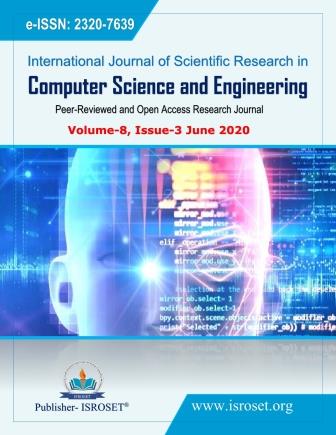A Machine Learning Approach for Diagnosing Meningococcal Meningitis
Keywords:
Meningococcal Meningitis, Bacteria Meningitis, Neisseria Meningitidis, Prediction, Machine Learning, Bayesian Belief Network ComponentAbstract
Meningococcal Meningitis is a hazardous sickness brought about by meningococcal microbes called Neisseria meningitidis which offers ascend to irritation of the meninges which influences people extending from babies, more established youngsters and grown-ups in particular old enough. The manifestations of this sickness are fatigue, nausea, seizures, vomiting, stiff neck, cold, sleepiness, skin rash, spasm, cough, loss of appetite, fever just to name a yet a couple. In late past, a few systems have been created to analyze this endemic malady; however they created a great deal of bogus negative during testing and couldn`t distinguish meningococcal meningitis, its overlapping symptoms and serogroup types. Thus, in this paper, we proposed and simulated a model to anticipate meningococcal meningitis and its serogroup types utilizing an AI strategy called Bayesian Belief Network. The model was structured utilizing Bayes Server and tried with data gathered from meningitis medical repository. The model had a 99.99% forecast precision, 97.12% sensitivity of Meningococcal Meningitis disease, 95.42% sensitivity of Serogroup type A, Serogroup type B, Serogroup type C, and Neisseria Meningitidis in that order
References
G.J. Tortora , B. Derrickson, ?Principles of Anatomy and Physiology?, (15th edition). J. Wiley. ISBN: 978-1-119-34373-8, pp. 1-10, 2016.
X. Saez-Llorens,G.H. Mcaleren, ?Bacteria Meningitis in Children?. Lancet.2003; Vol. 361(9375), pp.2139-2148.
H. Ahmed, ?Inflammatory Disease of the Central Nervous System in Paediatrics and Child Health in a Tropical Region? 2nd ed. Owerri, Nigeria, African Educational Services, pp. 525- 570, 2009.
World Health Organization, ?WHO Report on Global Surveillance of Epidemic-prone Infectious Diseases-Meningococcal Disease?, WHO/CDS/CSR/2000.1, Chapter 5: Meningococcal Disease.pdf, pp. 55-61, 2000.
Health Department, Republic of South Africa, "Guidelines for the Management, Prevention and Control of Meningococcal Disease in South Africa 2011". ISBN: 978-1-920031-63-3, pp. 1-48, 2011.
J.R. Zunt, N.J. Kassebaum, N. Blake, L. Glennie, C. Wright, E. Nichols et. al, ?Global, Regional, and National Burden of Meningitis, 1990?2016: A Systematic Analysis for the Global Burden of Disease Study 2016?. Lancet Neurol, 17(12): pp.1061?1082, 2018.
WHO Technical Task Force, ?Defeating Meningitis By 2030: Baseline Situation Analysis?. The 2010 MenAfriVac vaccine launch in Burkina Faso PATH/Gabe Bienczycki. pp. 1-54, 2010.
A.P. Hrishi, S. Manikandah, ?Cerebral Spinal Fluid (CSF) Analysis and Interpretation In Neurocritical Care for Acute Neurological Conditions?. Indian Journal of Critical Care Medicine, Vol. 23(2), pp. 115-119, 2019. doi: 10.5005/jp-journals-10071-23197.
Doherty, C.M and Forbes, R.B.:?Diagnostic Lumbar Puncture?. The Ulster Medical Journal, Vol. 83(2), pp. 93-102, 2014.
K. Revett, F. Gorunescu, M. Gorunescu, M. Ene, ?A Machine Learning Approach to Differentiating Bacterial From Viral Meningitis?. IEEE. Reprinted from IEEE John Vincent Atanasoff 2006. International Symposium on Modern Computing (JVA`06). IEEE, Los Alamitos, USA, ISBN 0769526438, pp. 155-162, 2006.
V.K. Mago, R. Mehta, R. Woolrych, E.I. Papageorgiou, "Supporting Meningitis Diagnosis Amongst Infants and Children Through The Use of Fuzzy Cognitive Mapping". BMC Medical Informatics and Decision Making, Vol. 12(98), pp: 1-12, 2012.
M. Langarizadeh, H. Khajehpour, M. Eftekhari, ?A Fuzzy Expert System for Distinguishing between Bacterial and Aseptic Meningitis? Iranian Journal of Medical Physics, Vol. 12(1), pp. 1-6, Winter 2015.
W. Ritha, W.L, Merline, ?Risk Factors of Meningitis in Adults-An Analysis Using Fuzzy Cognitive Map with TOPSIS?. International Journal of Scientific and Innovative Mathematical Research (IJSIMR) Vol. 2(4), pp. 418-425, April 2014, ISSN 2347-307X (Print) & ISSN 2347-3142 (Online).
N.D. Oye, L.L. Thomas, ?Fuzzy Model for Diagnosis of Bacterial Meningitis?. International Journal of Computer Applications Technology and Research, Vol. 8(2), pp. 33-51, 2019, ISSN: 2319?8656.
A.M. Abubakar, K.A. Abdulsalam, J.A. Adebisi, ?Application of Artificial Neural Network for Diagnosis of Cerebrospinal Meningitis?. Journal of Engineering Research, Special Edition, Vol. 24(2), pp.12-25, December 2019.
K. Zaccari, E.C. Marujo, ?Machine Learning for Aiding Meningitis Diagnosis in Pediatric Patients?. World Academy of Science, Engineering and Technology International Journal of Medical and Health Sciences, Vol. 13(9), pp. 411-419, 2019, ISNI:0000000091950263.
V.M. Lelis, E. Guzman, M-V. Belmonte,?Non-Invasive Meningitis Diagnosis Using Decision Trees?. IEEE Access, Vol. 8, pp. 18394-18407, January 29, 2020., Digital Object Identifier 10.1109/ACCESS.2020.2966397.
A. Simon, M.S. Deo, S. Venkatesan, D.R.R. Babu, ?Machine Learning and its Applications?. International Journal of Electrical Sciences & Engineering (IJESE), Vol. 1(1), pp. 22-24, 2015.
I. Ben-Gal, F. Ruggeri, F. Faltin, R. Kenett, ?Bayesian Networks?. Encyclopedia of Statistics in Quality and Reliability. John Wiley and Sons, Ltd. www.eng.tau.ac.il/bengal/BN.pdf/. pp. 1-6, 2007.
Kaggle Datasets, ?Disease Outbreaks in Nigeria Datasets: Predicting Meningitis Disease Outbreaks Using Machine Learning?, 2020.
Downloads
Published
How to Cite
Issue
Section
License

This work is licensed under a Creative Commons Attribution 4.0 International License.
Authors contributing to this journal agree to publish their articles under the Creative Commons Attribution 4.0 International License, allowing third parties to share their work (copy, distribute, transmit) and to adapt it, under the condition that the authors are given credit and that in the event of reuse or distribution, the terms of this license are made clear.







